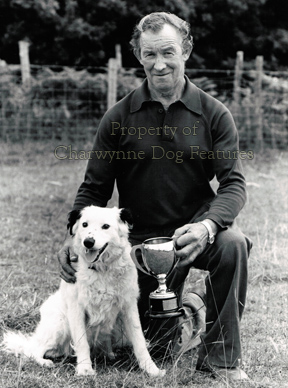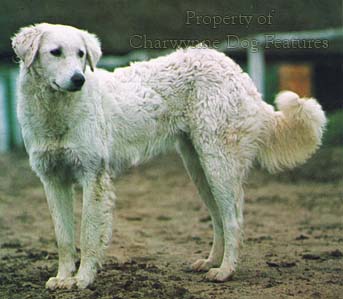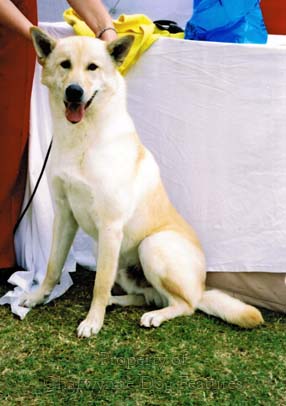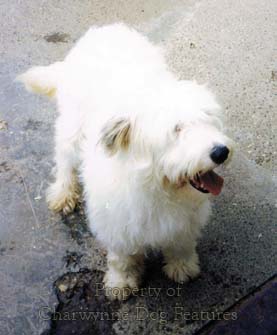439 White Pastoral Dogs
WHITE-OUT IN THE PASTURES
by David Hancock
 In 1877, a dealer in sheep and dogs, James Whitburn, was about to leave for New Zealand with a cargo of breeding sheep and rough-coated herding dogs, when he received a letter of warning. It was from his cousin John Logan of Lanarkshire and it contained these words: "Above all I urge you to beware of white collies. I have heard they do not inspire respect from sheep, but this is not the reason for the wisdom I offer you. I have found them recalcitrant, difficult to train and of a stubborn difficult nature. Two I have known, bred near Penicuik, have a reputation for savagery to their shepherds." The 'difficult to train' allegation in these words of warning could of course have been rooted in deafness in solid white dogs, a recurring problem in all-white dogs in some breeds. But usually blind prejudice beats fears of deafness every time.
In 1877, a dealer in sheep and dogs, James Whitburn, was about to leave for New Zealand with a cargo of breeding sheep and rough-coated herding dogs, when he received a letter of warning. It was from his cousin John Logan of Lanarkshire and it contained these words: "Above all I urge you to beware of white collies. I have heard they do not inspire respect from sheep, but this is not the reason for the wisdom I offer you. I have found them recalcitrant, difficult to train and of a stubborn difficult nature. Two I have known, bred near Penicuik, have a reputation for savagery to their shepherds." The 'difficult to train' allegation in these words of warning could of course have been rooted in deafness in solid white dogs, a recurring problem in all-white dogs in some breeds. But usually blind prejudice beats fears of deafness every time.
White-coated dogs are paradoxically both preferred and discriminated against in the world of the showdog, with glamorous breeds like the Samoyed and the Maremma sheepdog being prized because of their magnificent white coats whereas a white coat in breeds like the Boxer and the German Shepherd Dog is not desired. The nearly all-white Rough Collie is favoured in America but not here. I see many mainly white working sheepdogs but I doubt if a show ring Border Collie would get far in this hue. Contrastingly, in the two Hungarian herding breeds, the Pumi and the Mudi, colour is regarded more casually. The Pumi can be any solid colour; the Mudi can be black and white or those two colours blended. Coat colour matters hugely for some breed fanciers; breeders don't always declare a 'wrong colour whelp' cropping up in their kennel. This does not help any study of coat colour genetics.
Breeders of Kyi-Leos, Canaan dogs, Akitas, Pomeranians, Chow-chows, Pekingese and Polish Lowland Sheepdogs often have strong views on white coats in their breed. White is the natural colour for Pomeranians; the original bigger white variety, rather like the Japanese Spitz and Volpino of today, was a most beautiful dog -- now lost to us through human whim. Colour-prejudice in pedigree dogs is widespread yet admits to no rhyme or reason, with the parallel desire and distaste for all-white shepherd dogs aptly illustrating this conflict. I wonder how many outstanding dogs have been lost to us down the years just because of colour prejudice in breeds. Working breeds were handed on to us because of their quality not their coat colour.
For a fancier to opt for a colour other than white in his preferred breed is an exercise in personal choice. But for an approved breed standard to exclude or frown on white as a colour is somewhat dictatorial and can so easily consign an otherwise excellent white pup to oblivion. Where is the logic in white being encouraged in the Maremma, Kuvasz, Komondor, Pyrenean mountain dog, Owtcharkas, Schafpudel and Algerian sheepdog but discouraged in some other pastoral breeds? Again and again, you can read the tired old theories about the white dog merging better with the sheep or the shepherd being able to see the white dog better at night or sheep not being able to tell a non-white dog from a wolf. Such theorists conveniently overlook the fact that most sheep are not white and that most flock-guarding breeds are not white either, like the Caucasian, the Anatolian, the Karst, the Croatian, the Fonni, the Estrela mountain dog, the Tibetan Mastiff, the Vikhan, the Powinder, the Bhotia, the Bangara, the Bisben, the Cao Rafeiro do Alentejo and the Appenzeller mountain dog, some of these actually being wolf-colour. The breed standards reveal the irrational prejudice. 
In the Bearded Collie, white should not appear above the hocks on the outside of the hindlegs. In the Border Collie, white should never predominate. In the Bouvier des Flandres white predominating is highly undesirable. In the Rough and Smooth Collies mainly or wholly white is not recognised. In the Estrela Mountain Dog white markings are tolerated but are considered undesirable. In the German Shepherd Dog whites or even near-whites are highly undesirable. In the Old English Sheepdog, white patches in the main colour are discouraged. In the Shetland Sheepdog patches of white on the body are regarded as highly undesirable. In the Cardigan Corgi, white should not predominate.
In each of these breeds, quite rightly, the working origin is revered by the breed-devotees. Yet in the pastures, shepherds have never discriminated against a good working dog on the grounds that it was the wrong colour. There are many mainly white working sheepdogs but I have seen none in Border Collie classes at conformation dog shows. Once again, the armchair experts home in, e.g., the Border Collie is a "strong-eyed" dog and the strong-eye has a much greater effect on the sheep it is trying to control if it is set in black rather than white. Why then do such outstandingly strong-eyed but white-headed dogs as Wilson's Cap (the founder of all modern working dogs), Tim Longton's Roy, Squires's Jaff, McTeir's Ben, the Scottish champion Spot and British Supreme champion in 1975 and 1979, Zac, reign supreme ? Are we breeding for the best or solely for colour-favouritism?
One of the best security dogs in the Armed Forces in recent years was a white German Shepherd Dog. Captain von Stephanitz, a pillar in the development of the breed, once wrote:..."our German sheepdogs have never been bred for colour, the latter being of complete indifference in a working dog." I haven't seen that written in more recent times. I can understand the very sensible wish to avoid breeding albinos and to retain good pigmentation but find it hard to justify penalising a really good dog because of the colour of its coat.
The Pomeranian sheepdog, now lost to us, was a pure-white German sheepdog. The dog acknowledged as the foundation dog of contemporary German Shepherd Dog bloodlines, Horand von Grafrath, born in 1895, had a white grandsire. But after the death of von Stephanitz, white dogs were discriminated against, leading to their disqualification in Germany and then in America in 1968, from conformation shows. One was however the top obedience German Shepherd in America in 1968. In 1978, a white dog was the top dog in the US police canine association and a white Canadian GSD police-dog has been credited with over 200 arrests and rated highly. I can find nothing but admiration for the white GSDs in the Hoof Print kennel of Joanne Chanyi in Ontario; why should such admirable dogs not be accepted on merit?
In 1968, the German Shepherd Club of America voted to 'disqualify' white dogs in its breed standard. For the first time in its history, since its 1913 establishment, registered purebred dogs were banned on colour grounds alone. But breed historians have discovered that of the thirty dogs identified as 'pillars of the modern breed of GSD', 18 either produced white dogs or had direct descendants which were white, often continuing white bloodlines through lots of early champions. Dr Neufeld writing in 1970 gave the view that: "...white shepherd dogs played a paramount role in creating the remarkable German Shepherd Dog...are intimately intertwined with and all but inseparable from the breed generally." For playing that foundation role the white GSD then gets banned!
Dr Eugene Carver, in a 1984 article in the reputable Journal of Heredity on coat colour genetics in the GSD, wrote that vets who have examined white GSDs reported that they had observed no physical abnormalities or mental problems associated with the white dogs. I know of no reports linked to authoritative research which documents any deficiencies in white GSDs linked to their colour. On the contrary, whole volumes of information exist from breeders, owners, vets, breed historians, geneticists and scientific researchers indicating that white GSDs are normal in every way. A survey of 53 breeders of white GSDs, involving 5,320 white dogs, conducted in 1988, established that only a single dog was reported to be deaf. Any rational explanation of prejudice towards white GSDs would be likely to be found in human behaviour rather than in the genotype of the breed itself.
The Akbash and Karabash lobbies within the Anatolian Shepherd dog fanciers continue to dispute the true significance of the all-white colouration. The late Brian Plummer, terrier-breeder, lurcher expert and country sports writer extraordinaire, successfully bred a solid white Bearded Collie from a mating between two merles, a blue-eyed dog with no signs of albinism, dwarfism or deafness. He also bred some high quality white GSDs. But he was the last person to be deterred by convention, prejudice or perpetuated bias. He once wrote: "...there is a belief that these white-headed Beardies do not inspire fear among sheep. Sheep do not respect them. This is bunkum. 'Hillhead Tilly' is white-headed but will terrify a Jersey bull." He was acutely aware of the dangers of breeding both merle to merle and in breeding whole white dogs. His white GSDs were highly rated by all those who owned one. His white Beardies all became working sheepdogs.
Fifty years ago, I was visiting a remote farm in northern Norway when I became highly impressed by a white spitz herding dog. The farmer called it his cow-dog (buhund) and had chosen it from a litter of six, two creams, two reds, a black and this white one. It turned out to be a quite brilliant herder, on sheep as well as cows. It had a black nose and black eye rims. It was pure white, without any other markings. It was superbly constructed and moved with great drive. This outstanding working dog is always in my mind when I see the Norwegian Buhund classes at dog shows. I see wheaten, black and light red dogs there, some with small white chest and head markings, but never a solid white dog. The impressive herding dog I saw in northern Norway all those years ago had such a local reputation that it was almost certainly bred from; farmers don't get excited about colours in their working dogs. This dog was worth breeding from; it had style, substance, speed. stamina, eagerness to work and was extremely handsome; it was not an albino but would probably be unwanted today. Albinophobia should never lead us into overlooking gifted dogs in any breed. 
Burns (1952) suggested that the true albino may be blue-eyed, but Little (1957) indicated that this was incorrect. Robinson (1990) reported that: "The homozygous merle is white or almost white, with patches of coloured hair on the head. Some individuals develop into fine dogs, but the majority suffer from one or more defects. These include blue iris colour, deafness in one or both ears, and reduction in size of the eye, even to the point that one or both eyes may be absent. In general, it is advisable that white merle animals should not be bred." Whitney (1947) writes that: "Inbreeding blues (i.e. blue merle collies) for several generations often so dilutes the color as to result in a white with very little blue present and the blue in these cases will again appear last on the ears of such an animal. This has led white breeders to seek type through the inbreeding of blues, but the results have never been satisfactory..."
None of us want to breed albinos, perpetuate congenital deafness or dilute the desired colours in our favoured breeds. We all like to see good pigmentation and strong colours in our dogs. There is no harm in preferring certain colours in pedigree breeds, especially where the coat-colour establishes 'type', as in red Irish Setters, Dandie Dinmont Terriers, Golden Retrievers, yellow Labradors, West Highland Whites, Kerry Blues, Wheaten terriers, Vizslas, Weimaraners, Dalmatians, Sussex Spaniels and Blenheim Cavaliers. But soundly-bred otherwise good all-white dogs should never be put down just because of irrational human whim or show ring decree. Their blood may be genetically important and surely even out of plain good sense there is no bad colour for a good dog. I still remember the strikingly-handsome, beautifully-tempered solid-white, still-young German Shepherd bitch brought into the vet's surgery where I worked as a teenaged kennel-boy over fifty years ago. It was destroyed on the instructions of its owner (whom it seemed to adore) - just because it was white.